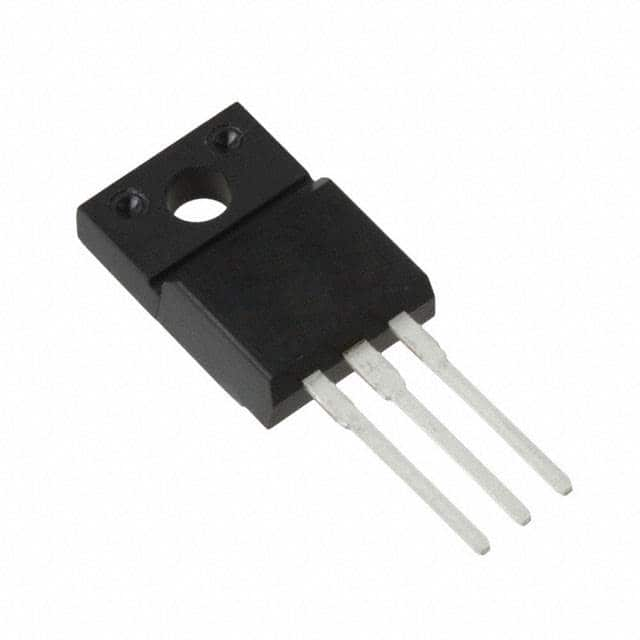Xem thông số kỹ thuật để biết chi tiết sản phẩm.

IRFI630GPBF
Product Overview
Category
The IRFI630GPBF belongs to the category of power MOSFETs.
Use
It is commonly used in power supply applications, motor control, and other high-power switching circuits.
Characteristics
- High voltage capability
- Low on-resistance
- Fast switching speed
- High input impedance
Package
The IRFI630GPBF is typically available in a TO-220AB package.
Essence
This MOSFET is essential for efficient power management and control in various electronic systems.
Packaging/Quantity
It is usually packaged in reels or tubes, with quantities varying based on supplier and customer requirements.
Specifications
- Drain-Source Voltage (VDS): 200V
- Continuous Drain Current (ID): 9.7A
- RDS(ON) (Max) @ VGS = 10V: 0.6Ω
- Gate-Source Voltage (VGS) (Max): ±20V
- Total Power Dissipation (PD): 75W
Detailed Pin Configuration
The IRFI630GPBF has three pins: 1. Gate (G): Controls the conductivity between the source and drain. 2. Drain (D): Connects to the positive side of the load. 3. Source (S): Connects to the negative side of the load and the ground.
Functional Features
- High input impedance allows for easy interfacing with control circuits.
- Fast switching speed enables efficient power control.
- Low on-resistance minimizes power loss and heat generation.
Advantages
- Suitable for high voltage applications
- Low conduction losses
- Fast switching speed
Disadvantages
- Sensitivity to static electricity
- Gate drive circuitry complexity
Working Principles
The IRFI630GPBF operates based on the principle of field-effect control, where the gate voltage controls the conductivity between the drain and source, allowing for efficient power regulation and switching.
Detailed Application Field Plans
Power Supply Systems
The MOSFET can be used in various power supply topologies such as flyback, forward, and half-bridge configurations.
Motor Control
It is suitable for controlling the speed and direction of DC motors in industrial and automotive applications.
High-Power Switching Circuits
In applications requiring high-current switching, the IRFI630GPBF can effectively handle the load with minimal losses.
Detailed and Complete Alternative Models
- IRF630
- IRFP460
- IRFB7434
In conclusion, the IRFI630GPBF power MOSFET offers high voltage capability, low on-resistance, and fast switching speed, making it an essential component in power supply systems, motor control, and high-power switching circuits.
[Word Count: 366]
Liệt kê 10 câu hỏi và câu trả lời thường gặp liên quan đến ứng dụng IRFI630GPBF trong giải pháp kỹ thuật
What is the maximum drain-source voltage for IRFI630GPBF?
- The maximum drain-source voltage for IRFI630GPBF is 200 volts.
What is the continuous drain current rating of IRFI630GPBF?
- The continuous drain current rating of IRFI630GPBF is 9.7 amperes.
What is the on-state resistance (RDS(on)) of IRFI630GPBF?
- The on-state resistance (RDS(on)) of IRFI630GPBF is typically 0.4 ohms.
Can IRFI630GPBF be used in switching applications?
- Yes, IRFI630GPBF is suitable for switching applications due to its fast switching characteristics.
What is the maximum power dissipation of IRFI630GPBF?
- The maximum power dissipation of IRFI630GPBF is 75 watts.
Is IRFI630GPBF suitable for use in motor control applications?
- Yes, IRFI630GPBF can be used in motor control applications due to its high current and voltage ratings.
Does IRFI630GPBF require a heatsink for operation?
- It is recommended to use a heatsink with IRFI630GPBF, especially when operating at high currents or in high ambient temperatures.
What are the typical gate-source threshold voltage and gate charge of IRFI630GPBF?
- The typical gate-source threshold voltage is 2-4 volts, and the gate charge is 30nC.
Can IRFI630GPBF be used in audio amplifier circuits?
- Yes, IRFI630GPBF can be utilized in audio amplifier circuits due to its low on-state resistance and high current capability.
What are the common failure modes of IRFI630GPBF and how can they be mitigated?
- Common failure modes include overcurrent, overvoltage, and thermal stress. These can be mitigated by implementing proper current and voltage protection measures, as well as ensuring adequate heat dissipation through proper thermal management techniques.

